
How Much Budget Do You Need for Content Marketing?
By now, you know that a great content marketing strategy makes a positive impact on business results. If you’re a larger business, you need to show the world that you are a leader in your industry. As a startup, you need to get attention, generate leads, and drive growth.
So the real question is how much do we need to spend on content marketing to drive growth in those areas?
Our own clients have proven that on average, content marketing delivers a 7x conversion rate. That’s $7 for every dollar spent. But where should you start?
Let’s explore 3 things you need to consider when setting the right budget amount for content marketing.
Quick Takeaways
- Because of the higher ROI, companies are allocating more budget to Content Marketing this year.
- On average, companies are allocating 25% of their marketing budget to content.
- Successful content marketers don’t just create content. They implement a strategy, identify goals, and measure results.
Content Marketing Becoming More Important
In uncertain economic times, short-sighted companies cut marketing costs, especially for tactics that show little ROI or are difficult to measure.
And while spending on advertising is down over the last year, content marketing appears to becoming more important to most companies.
The Content Marketing Institute reported late last year that 71% of B2B companies are putting more weight behind their content marketing efforts due to the overall measurability, value and ROI it can achieve.
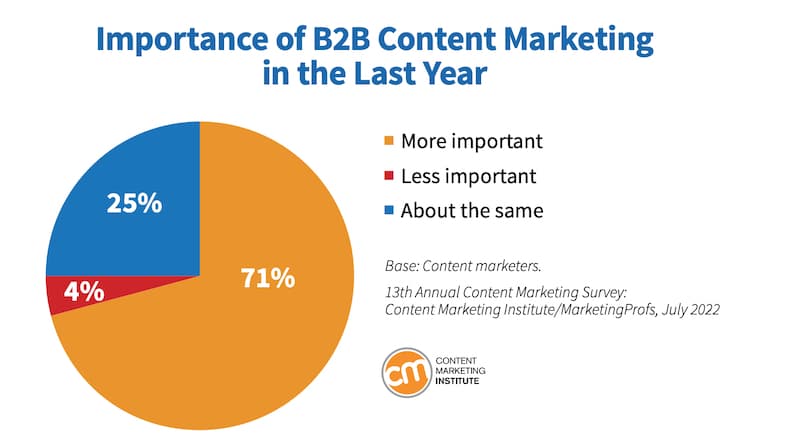
A recent study by Neil Patel also shows that 83% of companies are increasing their content marketing budgets in 2024.
Content marketing is becoming more important in 2023. It’s getting more budget. It is surviving the fear of an economic downturn because companies large and small need to grow in 2023 no matter what the economy is doing.
And content marketing delivers on that growth!
Ok so we know we need content marketing. And we know we need more content. Content marketing is more important. How do we go about setting a content marketing budget?
How Much Budget Do I Need For Content Marketing
Obviously every company has different needs and budget scenarios. So we can’t prescribe the precise content marketing budget number for every company. But we can look at some industry trends to better understand how companies are investing in content marketing.
Research shows that companies spend an average of 26% of their total marketing budget on content marketing. The most successful spend closer to 40%, and the least successful down to 14%.
Semrush’s recent report says that most 73% of companies spend more than $1,000 per month on content marketing, and the most successful spend as much as $10,000.
So how much does content marketing cost? Let’s say, from this research, the average content marketing budget is $5000 per month.
Our own content marketing services include strategy, content, and measurement start at $2500 / month for 1 article / week. We also offer $4500 / month for 2 articles per week. So I think your content marketing budget for us would fall in line for most companies budgets.
Again, none of this is one-size-fits-all, but the takeaway here is that while content marketing is extremely cost-effective, it also requires a substantial financial commitment — especially in the beginning stages, when you’re doing a lot of set up like content auditing, website optimization, and building your blog.
Must-Haves For Your Content Marketing Budget
The right strategy
Many of our clients come to us after having been frustrated after hiring a freelancer from Fiverr or Upwork. There are many great writers on those platforms. You can also find amazing full-time copywriters for around $70,000 per year in salary. But you still have to tell them what to right about!
An effective content marketing strategy defines the keywords your audience uses, the content they consumer, the channels where they consume it. So that you can identify the right kind of content to create in the first place.
This is where services like ours can be so valuable. We identify the pillars of content you need, the keywords your audience is using by looking at competitive gaps, long tail phrases, and purchase intent. We then brainstorm creative headlines for our writers to write for our clients.
And we measure results. We help our clients generate amazing stories of success such as 2-3x more leads, 300% traffic gains, 60% higher conversion rates and bottom line growth in revenue and new customers that translated into massive content marketing ROI.
So strategy is important. Creating the wrong content has a cost. But you also need the right team.
The right team
Great content requires great creators. One place you should never skimp on your content marketing spend is the right people to create your content. Haphazardly adding content creation to an existing role within your team without thinking about the time and expertise it requires is a dangerous strategy.
Content creators have specialized skills that optimize your content to get results. Here are some roles you might need to invest in as part of your content marketing budget:
- SEO writers can use keywords and other SEO best practices to optimize your written content to rank on search engine results pages (SERPs).
- SEO specialists optimize the technical aspects of your website to rank on SERPs.
- Copywriters are trained to write high-quality, high-performing written advertising and marketing content.
- Editors who make sure the content meets your brand guidelines
- Support staff who can upload, publish and share your content
- Demand generation specialists who know how to help drive conversions
- Paid media specialists who maximize the efficiency of your spend
(Or you can just hire us because we have all these folks already.)
The list isn’t limited to these roles but does include the most commonly needed skills in a content marketing team. Again, assigning these responsibilities to a team member without the appropriate skills and training will likely result in underperforming content.
You can also invest in a content marketing agency to handle your strategy for you. Good agencies have the expertise and resources to deliver consistent content, proven strategies, and frequent performance reporting. This frees you up to focus on other strategic priorities.
While outsourcing your content creation is an investment, it’s often more affordable than hiring full-time staff and it allows you to be confident in your content strategy without being bogged down by the work it requires.
Technology tools
Automation, data analytics, social media — all of these are important components of a good content marketing strategy. You can optimize your capabilities in each of these areas with technology tools to support them.
These tools give you important data insights and allow you to scale your strategy to reach larger audiences. Some examples include:
- Email marketing software enables you to store, email and track content subscriber lists and provides templates for creating well-designed emails.
- Social media software gives you the ability to digitally house your content calendar, automate posting, post simultaneously across platforms, and access performance reports.
- Google analytics gives detailed reports on web traffic.
- Website CMS platforms have analytics capabilities that every company should be taking advantage of as part of their website management.
- CRM platforms are more comprehensive and allow companies to automate sales, marketing, and reporting processes.
Your content
Depending on how your team is built, your content may or may not come with its own separate price. Often, though, specific projects that fall outside of the scope of a contract with an agency may require additional costs.
These can include anything from professional produced videos to white papers to print brochures and more.
We charge anywhere from $3500 to $5000 for e-books
Think about what types of print and digital content you’ll be creating and incorporate those potential costs into your budget.
How To Think About Your Content Marketing Budget
First, we need to have a solid understanding of your organization’s current content costs and utilization. Let’s start with calculating costs.
Step 1: Conduct an audit for a sample of the content your organization produces.
Step 2: Apply the average costs in order to gain a sense for the size of the problem. When calculating this, keep in mind to include the costs of freelancers, salaries, technologies, etc.
For this example, let’s say your organization is creating 1200 pieces of content per year with an average cost of $200 each. Therefore, your organization is spending $240,000 on content every year.
Next, we need to understand how much of your organization’s content actually gets used. On average, 60-70% of content goes completely unused; and remember, content that gets created, but never used is 100% waste.
The mistake companies often make when it comes to setting up a content marketing budget is thinking strictly in financial terms. Like: here’s what we can afford, so here’s our budget. Now let’s spend it.
But your content marketing spend is way more than just a number. Thinking only in terms of what you can spend without thinking seriously about how you can execute will lead to a lot of wasted money and unneeded frustration.
In short: don’t budget for money you won’t have the time or resources to spend, and don’t spend money on things you can’t execute effectively.
There’s no magic formula every company can use to determine their perfect content marketing spend, and the truth is that no budget will ever get it exactly right. But by thinking intentionally about creating a smart budget that capitalizes on every dollar spent, you can set yourself up for success.
We recommend looking at your content marketing budget from a prioritization standpoint: what are the most important items in your budget? Think about how you’ll execute each of these items. What will your timeline for execution look like? Which people or teams will be responsible? What other resources will this require?
Clearly outlining all of this during the budgeting process can help you identify what you can realistically execute well. Once you get to a point where you think you’re spreading resources too thin, it’s time to think about cutting lower-priority items out.
Our recommendation: definitely do set stretch goals, but prioritize setting your teams and your company up for success. Use your best judgement to set a budget that contains the right balance.
How to Budget for Your Content Marketing
Here’s a step-by-step guide to preparing and using a content marketing budget:
Step 1: Identify Your Goals
When compiling your budget needs, it’s best to start with the goals you hope to accomplish with content marketing. By establishing your goals, you’ll be able to determine the types of content you’ll create, the quantity of content, what resources are needed, and what channel costs you may incur.
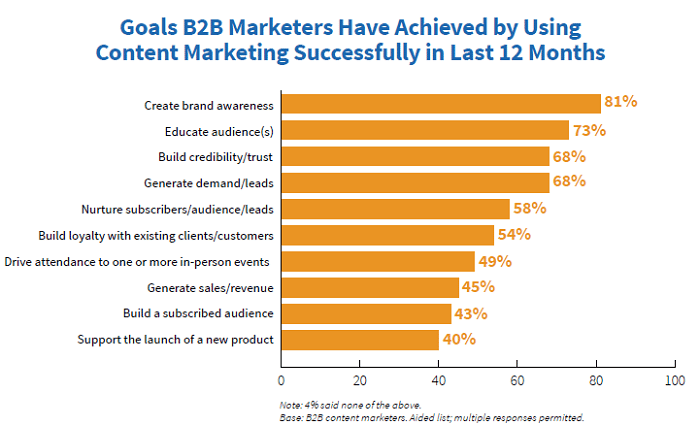
For example, if one of your goals is to improve SEO rankings, then you might decide to budget dollars for paid search ads, consulting services from an SEO firm, or specific technology tools that help you manage SEO efforts. If your goal is to increase lead generation from content, then you’ll be planning a lot of gated content, so you’ll need to budget for a landing page creator platform and ad spend for channels like social media.
Step 2: Define Resources
In defining resources, these would include human and technological ones. If you plan to double your content output in the new year, then you’ll need to either add to your internal team or consider outsourcing some aspects of your content marketing. No matter which you choose, it will come at a cost.
Beyond human capital, there’s all the technology you need. There is a wide selection of marketing technology platforms from which to choose. You might not need all the bells and whistles, but you will require some level of technology to eliminate inefficiencies and enable you to automate certain functions as well as track and measure your content’s performance.
Even if you don’t foresee any changes to your current tech setup, that doesn’t mean the price will stay the same. In addition to the base price increasing, you may need to add more users if your team is expanding. Be sure to include this in your 2021 budget.
If you are looking to switch platforms or add new ones, then you’ll need to do the research to see what best fits your needs and meets your fiscal limitations. For example, content personalization is a huge trend in content marketing. It requires robust technology like a CRM platform to pull it off, so if you have a goal of delivering more hyper-personalized content to buyers, figure in this new cost to your budget.
Step 3: Determine Channels That Require Spend
Not all content marketing efforts cost money. While it’s free to have a profile on social media, to optimize this channel requires some investment. Another channel where you may choose to allocate dollars is paid search ads. But how do you know which channels deserve budget? You can by looking at overall trends.
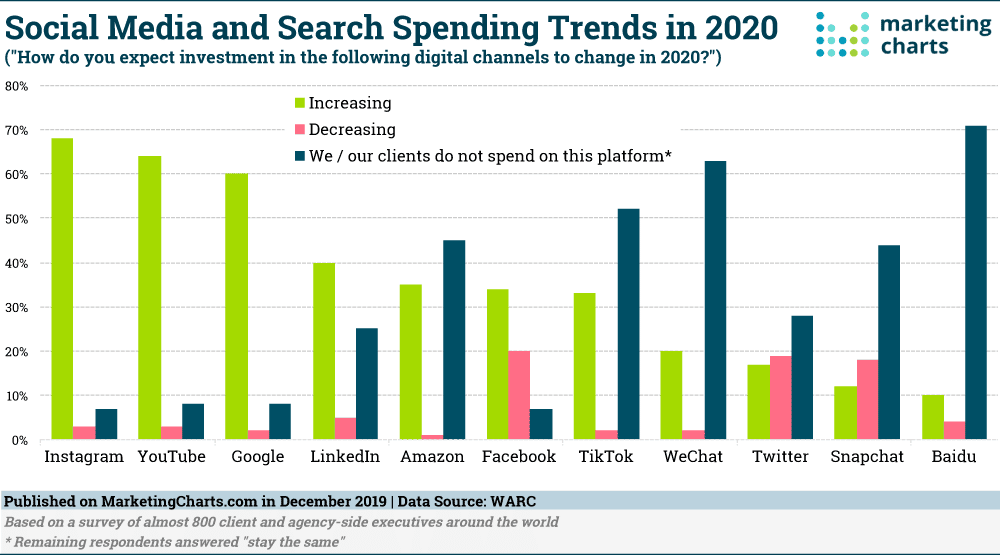
Then you’ll want to determine how those channels performed for you last year. If you ran paid ads on any social media profile, you should be able to determine the success of those campaigns. If you spent $2,500 on LinkedIn ads which generated a healthy amount of leads and revenue, then consider upping that budget in 2021.
For paid search, you may have mixed results. Dig into these to see what keywords are still worth bidding on in 2021. Depending on the competition for those keywords, bids could go up or down. Plus, you’ll want to renew keyword research for any emerging terms that are applicable to your industry.
The most important thing in paid search is to be smart about bidding and focus on where you see results. For example, if you see conversions only on certain days or times, then target those specifically, and don’t waste money on days that aren’t fruitful. You can do the same thing for locations. If certain states have better returns, then funnel your money toward those.
Step 4: Support Thought Leadership and Influencer Marketing
Thought leadership will continue to become even more critical to content marketing. In fact, PAN’s Content Fitness Report also found that 61% of respondents believe it should be a priority.
And while thought leadership should be an organic strategy, that doesn’t mean it won’t require funds. There are certain activities that will require dollars and resources to establish your brand as a thought leader. These may include dollars for trade shows where company subject matter experts (SMEs) lead sessions, partnering with industry publications for sponsored content or fronting the costs for an SME to write a book. Further, one of the most familiar expenses for thought leadership may involve tapping a PR firm to get your brand featured in the media.
Advocacy marketing is another area that should be factored into your spend. Building a Voice of the Customer program or carrying out employee advocacy efforts that integrate with your content strategy will require some budget. The amount of budget necessary will depend on your goals, internal resources, martech infrastructure and several other factors.
Influencer marketing was also a key budget area that aligns with advocacy marketing. According to the Content Fitness Report, 25% of marketers say they’d include budget dollars for this initiative. Your influencer strategy should be closely integrated with your content marketing efforts to make sure you’re maximizing your results. Influencer marketing should also be a high priority because it adds authenticity and authority to the brand when experts stand behind it.
Step 5: Check for Gaps
It’s easy to forget budget items during the planning process. But you don’t want to be halfway through the first quarter and not have money for an essential need. The last step in budgeting is to go through each line item and assess them thoroughly to ensure you haven’t missed anything. It’s better to start out asking for more than to try to push something through later in the game. This includes budgeting for tools and technology.
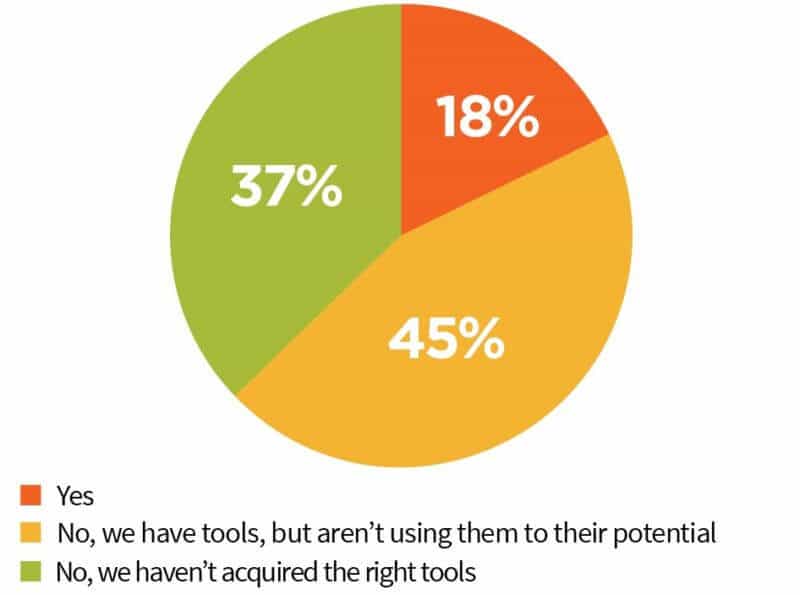
Insider Tips to Get More Out of Your Content Marketing Budget
Here are some tips to maximize your content marketing budget through a strategy that is data-based, flexible, and effective.
1. Know (and Show) What Content Marketing Can Bring to the Table
To set up a budget that will position your content marketing to succeed, you need to be aware of the value content marketing can bring to your company. Even though content marketing costs 62 percent less than outbound marketing, it triples the number of leads. Even better, it delivers six times the conversion rates of other marketing strategies. That means that content marketing, not advertising, should get the lion’s share of the marketing budget.
2. Estimate the Funds You’ll Need to Level Up Your Technology and Skills
When you invest in content marketing workshops, courses, and subscriptions to industry journals, you and your team increase your ability to communicate your company’s message effectively. Coupled with cutting-edge technology’s ability to extend your reach to your target customers through data analysis and targeted messaging, your improved message gets amplified even more.
These improvements are a vital part of any successful content marketing strategy, so you need to factor them into your content marketing budget.
3. Make Sure You Make the Most of the Budget You Have
If your goal is to increase your budget yearly, you need to show that you have leveraged your current budget to the greatest extent possible. When you realize that on average, 70 percent of content that B2B content marketers create doesn’t even see the light of day, you need to conduct a thorough audit of your content strategy.

Focus on creating higher-quality content that you can use, repurpose, and reuse. Track the effectiveness of content. If you find out a particular type of content isn’t performing, cut it. Even if it goes against the grain of “we’ve always done it that way.”
4. Review the Nationwide Statistics for Content Marketing Budgets
Although for most companies throughout America, only 22 to 26 percent of B2B companies’ marketing budget goes to content marketing, the most successful ones allocate nearly 40 percent to it.
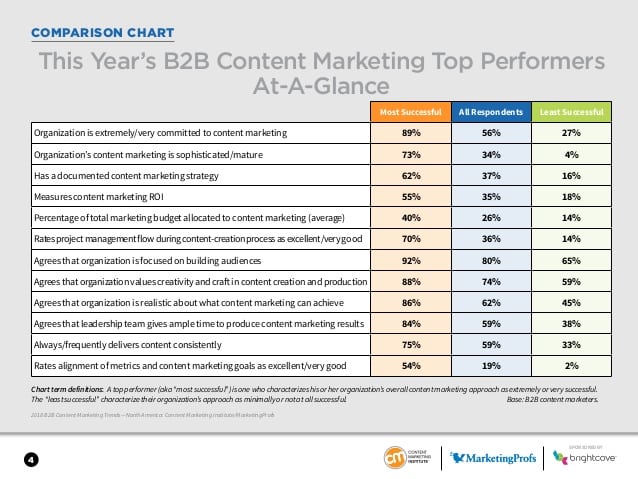
If you’re a solo entrepreneur, you can bump up the percentage yourself. If, however, you’re in a larger company, you need to create a convincing argument to those who hold the purse strings that content marketing is indeed worth the investment. Looking at these statistics is your first step.
5. Look at Your Competitors’ Content Marketing Spend
You’re focused on getting that 40 percent that the most successful businesses get. The way to get to that number is to find out what some of your competitors have likely spent on their content marketing. You might not be able to score a copy of their corporate budget, but you can get a ballpark estimate by looking at their content and adding up the average cost of such content.
According to a State of the Creator Economy report, American businesses pay, on average:
- $330 for a video
- $115 for a list and advice article
- $147 for a photograph
- $190 for a motion graphic
- $127 for a listicle
- $311 for a white paper
- $183 for an industry insight feature
- $144 for an infographic
- $168 for a trend piece
If you’re not exceeding your competitors’ content output, you need to open up your purse strings and make room in the budget to do so. If money is tight, look for creative ways to repurpose your content, such as expanding the content of an article into a white paper or using an existing article as a basis for a video script. Consider using your content as the basis for podcasts, webinars, or informative talks.
6. Consider Your Company’s Size and Your Industry
Large companies might have the funds to hire in-house content marketing teams, but it’s often more cost-efficient to hire a content marketing agency with a team of specialists, each of whom has expertise in his or her niche. As for small- to medium-sized businesses, most need to outsource the lion’s share of their marketing, unless they have someone in-house with a knack for producing killer videos, informative articles, and dazzling graphics. For startups, it can be as simple as cutting out the Starbucks to cover the costs of a blog on your website, as digital marketing guru Neil Patel advises.
If you’re in a highly competitive industry, it’s likely you’ll have to spend more on content marketing to make sure you’re getting the edge you need to rise to the top of your niche. If your company is short on money and long on ideas, put some of those ideas to work, spend a little more time on the job, and create quality content of your own.
7. Don’t Forget to Add in Content Promotional Costs
If you use an automated email service to send newsletters or other content to subscribers, be sure to include that in your base content marketing budget. Also, estimate the funds you’re likely to need for ads that promote your blog posts, white papers, videos, and other content on social media.
- Cost Per Mille (CPM, from the Latin mille – meaning “thousand” – impressions): When you promote your content online, you need to factor in whether your goal will be primarily brand awareness or funneling traffic to your content. If you’re a startup, or if you’re introducing a new product or service, you might prefer a cost-per-thousand impressions (CPM) model for your promotional ads. In that case, the more impressions, the more awareness you build among your target audience.
- Cost Per Click (CPC): Usually, however, when you promote content, you fare better when you use the cost-per-click (CPC) model to calculate your projected costs. Since the goal is to get your audience to read, watch, or listen to your content, CPC is usually a better model for content marketing.
In 2019, the average CPM on various media is as follows:
- Google: $2.80
- Twitter: $5.76
- LinkedIn: $6.05
- Instagram: $6.70
- Facebook: $9.06
The CPC costs for the most popular platforms are as follows:
- Google: $0.75
- Twitter: $0.53
- LinkedIn: $5.61
- Instagram: $1.28
- Facebook: $0.51
8. Analyze Your Past Budgets for Cost and Effectiveness
Unless you’re a startup, your budgets over the past few years will be a rich source of data that can help you see what worked and what did not. Use Google Analytics, social media analytics, as well as your email and automated marketing systems to see which platforms and content types produced the most leads and revenue, as Mark Schmukler advises.
- Boost your best performers: Allot more of the coming year’s budget to the types of content and promotional types that worked best. Cut out—or cut back on– the poorest-performing types.
- Be flexible: Allow some wiggle room in your budget to make changes when new, more effective marketing strategies emerge. For example, when mobile platforms first emerged as major players, only those companies whose budgets were flexible enough to funnel more money into mobile content marketing could take full advantage of the new technology.
9. Borrow Budget from Underperforming Digital Assets
We know customers are tuning out advertising. $1 spent on digital banner ads will under-perform $1 on content marketing in almost any category. Don’t believe it?
- The average click-through rate of display ads is 0.1% (DoubleClick)
- Only 8% of internet uses account for 85% of clicks on display ads (and some of them aren’t even humans) (comScore)
- About 50% of clicks on mobile ads are accidental (GoldSpot Media)
In fact, you’re more likely to be struck by lightening than click a banner ad.
10. Approach Flushed Teams with a Partnership Opportunity
Advertising campaign landing pages are another traditionally expensive, yet underperforming digital asset to potentially borrow budget from. I once explained:
“There was a team at SAP that had an enormous budget for advertising campaign landing pages. Those pages typically saw a 99.9% bounce rate, and any traffic that went there was paid. I asked to take a small percentage of that budget with the promise of driving a organic traffic to the site. It was a win-win for both of us.”
Approaching other teams with big budgets with the opportunity for partnership rather than a threat to steal is a great way to put your content marketing strategy to action, while also building internal champions within your organization. For Michael, once he was able to deliver the promised organic traffic, his program proved its value and was able to justify funding in its own right.
Why Use Your Unspent Marketing Budget On Content Marketing?
When I first joined SAP in the summer of 2007, I was asked to identify all the marketing programs that delivered actual leads, sales and ROI. I spoke to all my colleagues, I dove into our CRM, I poured over our reports.
And what I found astounded me: 62% of our marketing budget was spent on activities that drove ZERO leads for sales. Not one lead. From almost two-thirds of our regional marketing budget that was supposed to focus on, you guessed it, driving leads for sales.
These campaigns typically came at the direction of the VP of Sales for those segments: let’s get a full page in an industry trade publication. We need a brochure. How about some boondoggle events?
Which programs actually drove results the sales teams loved: content marketing. One-third of the budget delivered 100% pipeline our sales team was looking for.
And they were all annually-planned content marketing programs.
There were 3 big reasons why these programs worked so well:
- They strategically planned customer-focused content to be delivered across the entire year
- They allowed time for constant optimization of the program to deliver the right leads at the right time
- They created their plans and spent their budget before the year started
You see, sales people are funny. I know. I spent my first 5 years in sales. In the beginning of the year we want LOTS of leads we can nurture into sales opportunities so we can hit our sales targets.
At the end of the year, we want only highly qualified leads so we can focus what time we have left on closing deals.
So content marketing that’s planned out now, before the year is over, allows you to hit the ground running with a strategy in place before the year even gets started. It allows you to deliver value to the company right from the start, and it allows you to change and optimize as you go.
What If We Don’t Know Our Campaign Priorities Yet?
I’m so glad you asked. See, the problem with campaigns: they define what you decide is important. With SEO-based content marketing, we use objective research of the customer questions, keywords and concerns to decide what’s important.
We use trending data on what topics are important in your industry. We define what gaps you have with your competition to figure out what you need to be talking about.
Sure campaigns can be weaved into the content plan. No problem. But at least you have a strategy to build an audience for those big ideas that I’m sure will change the world. Definitely!
How To Use Your Unspent Marketing Budget
How and where should you place the dollars from your unused marketing budget? In this post, we’re sharing the simple 7-step process we use for our clients who spend their unused marketing budget on content marketing for next year. We also lay out the costs you should expect to incur.
1. Align To Your Business Strategy
First step is always to start with the business case for your content marketing. How does it align to your business goals, your overall marketing goals, and how will you measure those results in the terms your executive team understands.
2. Build The Content Marketing Measurement Framework
I always like to use the framework of Reach, Engage, Convert, and Retain to cover all stages of the buyer journey.
- Reach: attract new prospects or customers to your business. While some marketers like to think of this stage as awareness. I find that a really tough thing to measure and an easy way to blow through budget. With reach, you can actually count the hard number in terms of visitors to your website or landing pages.
- Engage: Are you building a relationship with these new folks. How many times do they visit? How long do they stay? How deep do they go?
- Convert: This is the stuff we love count. Did they fill out a form, register for an offer, buy the product? Content marketing leads are 62% cheaper than other types because of the way we attract them with valuable content vs ads or trickery or persuasion.
- Retain: Content marketing-generated customers are “better” because they stay longer and spend more. 4x more revenue Lifetime Value (LTV) from our research.
Now that you’ve identified the framework, you can move into the defining the actual measures of success. Whether you call the KPIs (Key Performance Indicators) or OKRs (Objectives and Key Results), simply metrics or reports, you can define which data points will show whether you are successful at building reach, engagement, conversion, and retention
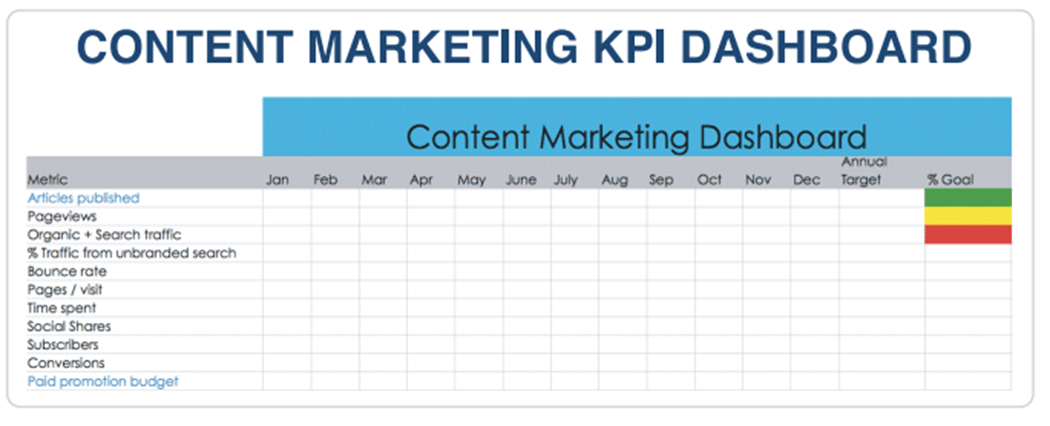
3. Conduct Keyword Research and Topic Modeling
We start all our content planning with deep keyword research. While aligning to your business strategy is important, we find user-based research is more effective at driving marketing plans than internal opinions about which campaign messages are most important. We follow these steps:
- Identify important themes or categories of content you want to create
- Research your SEO rankings and positions against those “short-tail” keywords. For MIG, examples include might be marketing, content marketing, etc.
- Look at search intent such as commercial intent (see below)
- Identify competitive gaps and opportunities based on high CPC keywords
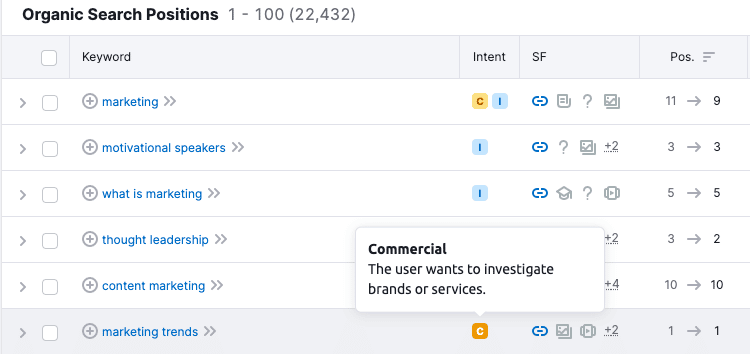
Source: Semrush
4. Brainstorm 100 Article Ideas
I know this sounds like a lot, but trust me, this exercise is easier than it sounds. Here’s a few tricks:
- AnswerThePublic: Type any focus keyword into Answer The Public and it spits out this entire content plan based on common questions people ask their search engines related to that topic. This is why I wrote Why Content Marketing Is Important and Why Does Content Marketing Take So Long To Work because real people are asking these questions and Answer The Public told me to answer them.

- Buzzsumo: Type any search term into Buzzsumo (License required) and it spits out hundreds of ideas based on the content ideas that have been shared the most. Buzzsumo told me to write about content marketing trends, AI-generated content, content marketing tips for startups, and why social media alone isn’t enough for business growth.
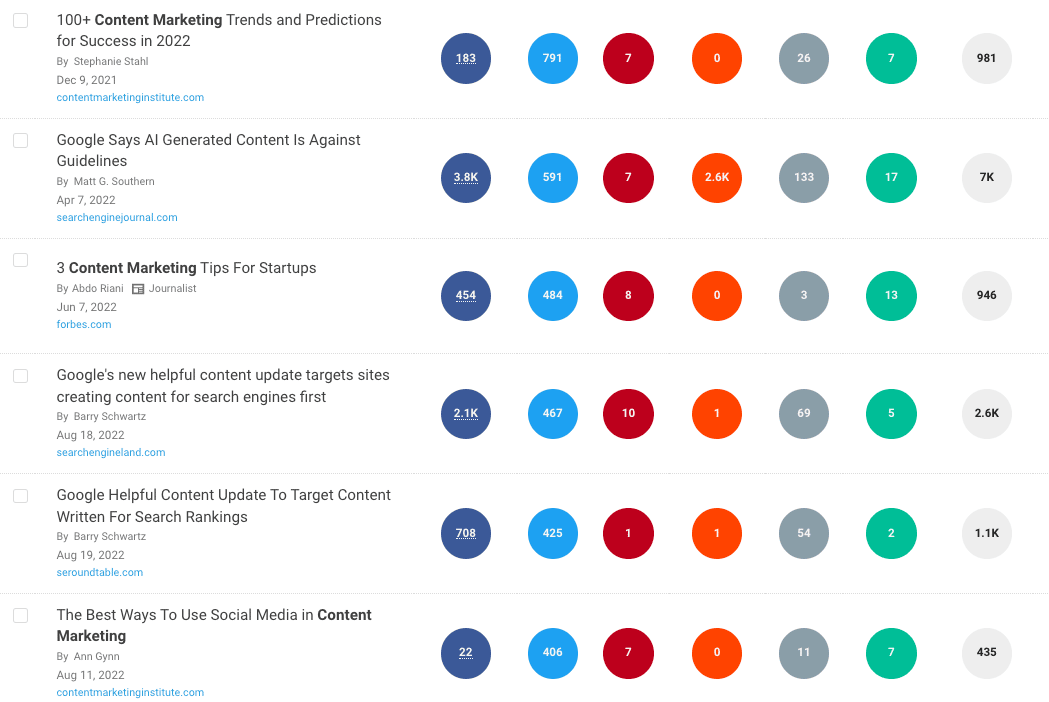
So with Semrush, you’re using search intent. With Answer The Public, you’re using search query data. With Buzzsumo, you’re using social sharing data.
5. Plan Your Entire Year’s Worth of Content
Now you have a general sense of your business strategy for next year and how your marketing strategy will support it. you know what keywords your audience uses, what content they like to share, what competitive gaps you have, and what you need to create.
So let’s use some of that unused marketing budget right here at the end of the year to pay for next year’s content! Here’;s the approach we use to plan it out:
Ask your team each to rank from 1 to 4 which article ideas they love (ranked as a 1), which ones they hate (ranked as a 4) and everything in between (2 = like and 3 = meh). Average and weight those rankings across your team. If you have 100 article ideas, plan to publish the article twice a week across the year.
Make sure you balance out the content themes. Here’s an example from our MIG blog last year.

6. Make Sure To Optimize or Update Old Content
Go the search bar on your website and type last year into it. Surely you’ll have some articles about last year’s trends that you’ll want to update. Or maybe you have articles from 5 years ago that still get some decent traffic or conversions. If you delete those pages Google may penalize your website. So instead, use some of your unused marketing budget to update those old pages.
Start by searching for article with year’s on them. Look for articles that have high traffic but are older than 2 years. Look for articles that still get lots of conversions or rankings that are more than 3 years old.
Now create a plan to update those using some of last year’s leftover marketing budget! Updating old posts is one of the most effective ways to generate leads and revenue without having to spend money generating new conte t ideas or new articles.
7. Promote Your Content Through an Employee-Generated Social Media Campaign
Employee-generated content is one of the most effective ways to boost the value of your marketing budget. Why? Because your target audience is more likely to trust content from your employees than from ads. It’s also a great way to boost the personal brand of your employees who are interested. And who knows, maybe some of them will even want to start writing for you.

We call this employee activation: getting your employees to write and share your content. Not because you made them do it (never mandate this) but because they want to. Engaged employees who create and share content are able to generate 2x the click through rate as brand-shared content.
Content Marketing Budget Examples for Every Size Business
$1000 / month: You really can’t go much lower than this. $1000 per month should get you around 2 articles for the month. Again, you could go on a freelancer platform for less but then you need to make sure you are creating content that aligns with your target audience and provides measurable value. Also keep in mind, that our own content marketing frequency research shows that you need to blog weekly to start showing real growth in traffic and leads.
$2500 / month: This will get you 1 article per week from us plus the annual content marketing plan, and monthly reports. Most of clients on this plan start to see growth in SEO and search rankings after about 3-4 months. The average growth rate is just under 100% for the year, so almost double your traffic and leads.
$5000 / month: this will get you 2 articles per week, the annual content plan, monthly reporting, and 2 demand generation e-books. Our clients at this spend level are seeing results a little but quicker: around 2-3 months. And they average 138% year–over-year growth in leads and traffic.
$10,000 / month: this gets you the supersized plan of strategy, content and paid promotion. You can expect to see growth like we explained above plus is happens immediately! At this level of spend, we see clients experience around 10,ooo new visitors per month in website traffic from month 1 and it just goes up from there as the organic traffic gains start to materialize. Over time, we also start to re-target those visitors with demand gen offers that translate to predictable leads and new customers.
Get ROI from Content Marketing: The MIG Way
The cost of content marketing ranges between $1000 and $10,000 per month depending on the variety of content types and the number of content pieces you need per month.
Our content packages are simple: we help our clients generate traffic and leads with an annual content plan and 1-2 blog articles per week. It’s simple and focused: 50-100 focus keywords, 50-100 creative article headlines, 1-2 blog articles per week, monthly Semrush tracking to prove that it works!
We charge $4,500 / month for 2 weekly articles. That’s just $54,000 for all of next year’s blog content. That is less than the cost of one event sponsorship or a month of PPC advertising. (If you’re interested, check out an ROI-focused case study, the success we see by using this service for ourselves and all our amazing G2 Reviews.)
The trick to setting up a marketing budget is like baking a cake, as Alex from Jotform tells us below. You have to have the right recipe, put the ingredients together, warm and the oven and you’re ready to go:
That’s why we shared our recipe for how to use your unspent marketing budget right now, to get the most delicious cake.
With MIG, not only do you get an entire year’s worth of content. But you start the year with a keyword strategy mapped to your buyer’s needs. You get 100 article ideas, weekly content to keep your lead machine humming along, and monthly reports you can share with your boss.
All this combined will bring the results you need next year. And it will already be paid for! That’s why now is the perfect time to spend that unused marketing budget on next year’s content marketing. When next year rolls around, you’ll look like a hero.
Do you want to use some of your unused marketing budget on content marketing. Our team of 35+ experienced writers are ready to produce content for YOUR business. Check out our weekly blog content service or schedule a free consultation.







Thanks Michael for the post and highlighting this topic. I think it is also important to have a strategy for reusing the original content in different formats and ready for multiple channels. As a part of my content strategy and budgeting, I plan for the buyers journey of my target audience – who they are, what stage of the funnel are they at, and where they are looking for finding the info. This means I can reuse the same content in multiple forms and post it on multiple channels. I usually map the content into my buyers (customers) journey to meet the needs of the target audience, while allocating some of the budget to the channels that I want to promote it on.
Great article which enlightens people on the budget concerning the growth of content marketing process.
Thanks for sharing, glad you like the post. It is crucial to keep the funnel stage in mind when building a content strategy, you are spot on!
Thanks for sharing, glad you like the post!